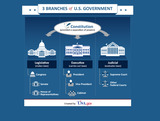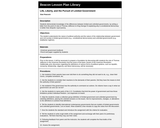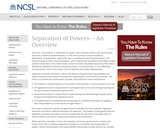
This is the PowerPoint and lesson plan associated with the lesson 8 Tribes, 1 State.
- Subject:
- Arts Education
- Social Studies
- Visual Arts
- Material Type:
- Presentation
- Provider:
- Carolina K12
- Author:
- Carolina K12
- Date Added:
- 05/12/2021

This is the PowerPoint and lesson plan associated with the lesson 8 Tribes, 1 State.

This resource is designed to assist students in understanding the differences of the 3 branches of U.S. government. It should take about 30 mintues to review the article and complete the graphic organizer. Answers to questions not found in the article can be completed as an internet research activitiy.

In this lesson, students learn how the Constitution established a new way to organize government called the federal system. Students will describe how federalism differs from other forms of government and identify strengths and weaknesses of a federal system.

Students will work on an independent project throughout their study of the Constitutional Period by researching a Constitutional topic and creating a float representing that topic. Students will then educate others on their topic by presenting their float in a class parade.

If students take away anything from Remarkable Journey, it is hopefully the incredible ways the Indian community has contributed to the progress, growth, diversity and richness of the state of North Carolina. In this activity (best conducted after students have been exposed to multiple clips or the entire film,) students will consider all that they have learned about India and its people then create movie poster for Remarkable Journey that they think best highlights these themes.

In this lesson, students will learn about the role of county commissioners in local government. After identifying the ways counties can elect commissioners, they will work in groups to rank county priorities and develop a political platform for a county commissioner running for election. Finally, the class will explore the local campaign process by participating in a mock county commissioner election.

This lesson plan facilitates discussion with students about the challenges that faced George Washington as the first President of the United States.

In this lesson, students will familiarize themselves with some basic facts about India that highlight its diversity. Students will then view excerpts from (or the entirety of) Remarkable Journey and utilize the film’s information as a jumping off point to learn about various aspects of Indian culture (food, music, film, clothing, dance, and religion.) Yet, despite such diversity, Asian Indian immigrants to North Carolina, fellow strangers in a strange land, often rely on their shared roots to build new and unified communities. Students will discuss this concept then use their discoveries to create a mural that exemplifies the theme: "India: Unity in Diversity."

India is a diverse land of religions and spirituality. It is not only the birthplace of Hinduism, Buddhism, Jainism, and Sikhism, but numerous other faiths are practiced there, including Islam, Christianity, Judaism, Zoroastrianism, and others. Through viewing clips from Remarkable Journey and completing the following activities, students will explore the various religions with connections to India, as well as the way Asian Indians have integrated their diverse religions into communities across North Carolina. As a culminating activity, students will delve further into one particular religion mentioned during class by creating a scrapbook of that religion.

Students will explore the Articles of Confederation and the Articles' influence in revising the Constitution of 1787. Students will experience the sentiments of Federalists and Anti Federalists by participating in a partner debate as either North Carolina Federalist James Iredell or Anti Federalist Willie Jones.

In this lesson, students will learn about the North Carolina General Assembly and the role of representatives and senators in a bill becoming a law.  Students will apply their knowledge by participating in a legislative simulation in which the NC Senate Judiciary II Committee determines whether to report a proposed bill on school violence prevention as favorable on the floor of the Senate.

In this lesson, students will consider immigration in general as well as through the specific lens of the Asian Indian immigrant experience by viewing clips from Remarkable Journey. Students will explore their own immigrant ancestry as they consider the concept of America as a "Nation of Immigrants," as well as the varying reasons for immigration throughout history, the varied experiences of immigrants, their relationship to the American Dream, and the misconceptions that often frame immigration in our society. As a culminating artistic activity, students will create an updated Statue of Liberty - a new design that addresses immigration, America as a "Nation of Immigrants," the concept of the "American Dream," and the related concepts addressed throughout the lesson.

In this lesson, students demonstrate knowledge of the differences between limited and unlimited governments, by writing a letter from the point of view of Thomas Jefferson to King George III explaining why a constitutional democracy is better than despotic royal tyranny.

In this lesson, students will learn about the position of North Carolina’s governor, his/her roles and responsibilities, and the relevance he/she has to each North Carolinian. Students will explore the skills and qualifications necessary to be governor by assuming the role of North Carolina’s governor and problem solving various realâ€life scenarios. Finally, students will create a commercial or poster as part of a public awareness campaign to inform North Carolinians about the office of the governor and its relevance to every citizen.

In this lesson, students will learn how the North Carolina Constitution is relevant in today’s world. They will view and take guided notes from a Power Point that explains the changes made to the state Constitution since its ratification in 1776, helping students understand that the state Constitution is a “living document†and that is can be updated to reflect the times while keeping its core principals the same. Students will then complete a “Comparing Constitutions Scavenger Hunt†where they will examine the NC and US Constitutions and compare the differences and similarities. The lesson culminates in a “You Be the NC Supreme Court Justice†activity where students examine a scenario and determine its constitutionality.

In this lesson, students will reflect on the principles upon which this nation was founded as well as the major events that have shaped this nation to address the question: to what extent have the American people lived up to the principles of the American political system? Students will assign the nation a grade based on their perceptions of the degree to which the people of the United States have lived up to their nation's founding principles.

This file is the PPT accompaniment for "Teaching Activities for Remarkable Journey." "Remarkable Journey: Founding the Asian Indian Community in North Carolina" is a documentary that illustrates the history, culture, lives, and contributions of Indian-Americans in North Carolina.

In this lesson, students will receive an introduction/overview of the US Constitution through reading, an optional Power Point presentation and class discussion. Focusing on the underlying principles of the US Constitution, students will create public service announcements on the Constitution, its relevance, and the principle assigned to their group. In presenting their PSAs to classmates, students will review and learn additional details regarding how the US Constitution defines the framework and organization of our national government.

In this lesson, students are introduced to the office of President by discussing the qualifications necessary for serving in the office, as well as the roles and powers of the President as prescribed by the U.S. Constitution. Students will exercise these roles and powers themselves by assuming the position of President of the United States of America.

This resource provides an overview of the separation of powers.